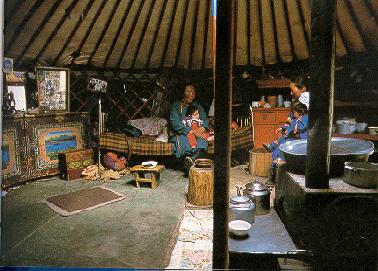What is a Ger (Yurt)?
Yurt is the name commonly used to refer to a Mongolian Felt Tent or Ger. Mongolians do not usually appreciate the term because it is most often used by Western invaders. So, in spite of this page's title, we will attempt to use Ger where ever possible.
A Ger is really more than a tent. The Mongols live in them year round and tend to prefer them to other forms of housing. The design has been developed for generations to suit the needs of its inhabitants. It can be warm in arctic cold, yet cool in summer. The structure can collapse small enough to fit on one draft animal and can be set up again in a half an hour. |
Here are a couple of pictures showing the inside of the ger. To the right is a view looking from east to west, from the women's side to the men's side. By tradition the ger always faces south, with the eastern side being the women's and the western side being the men's side. This applies to sitting arrangements and arrangements of household goods. This is a reflection of the Mongolian cosmology, which is described in the shamanism page. In the center you can see the gulamta, place of the fire, with the tulga, three rings supported on legs which is the framework for holding pots and roasting spits. On the far wall is the goatskin bag for making airag, also known as kumiss, an alcoholic drink made from mares' milk. The handle sticking out is used for churning the milk while it ferments. Behind it the wooden framework of the ger is clearly visible 
|  |  |  |  There are three main types of yurt in use today. The Turkic or Khazak yurt with a bentwood roof and crown, the two tiered yurt, with a pointed roof, and the Mongol Ger. The Mongol ger is the yurt in most common use today, being home to three-quarters of Mongolia's people. The Mongolians use the word ger, meaning home rather than yurt, which is of Russian origin. There is evidence that yurts were used by the Scythian and Pazaryk peoples 2500 years ago.
The Mongolian ger has straight roof poles and heavy timber crown, supported by two upright posts, or bagana. These posts are of cultural significance, and in normal use, are not a structural necessity, they do, however give added stability in very high winds. The walls consist of between two and ten trellis sections or khana, which interlock and are tied together to form the circular wall. The traditional covering is felt, made by beating and rolling wet sheep fleece. Felt has excellent insulation properties and is sufficiently waterproof for the dry central Asian climate. A decorative white cotton cover is often added. The ger can be put up in half an hour and taken down in fifteen minutes.
|



